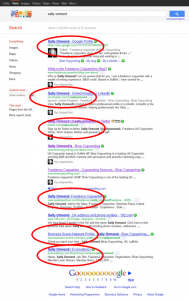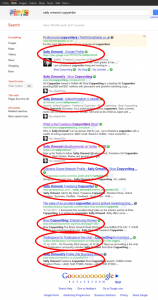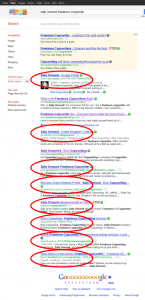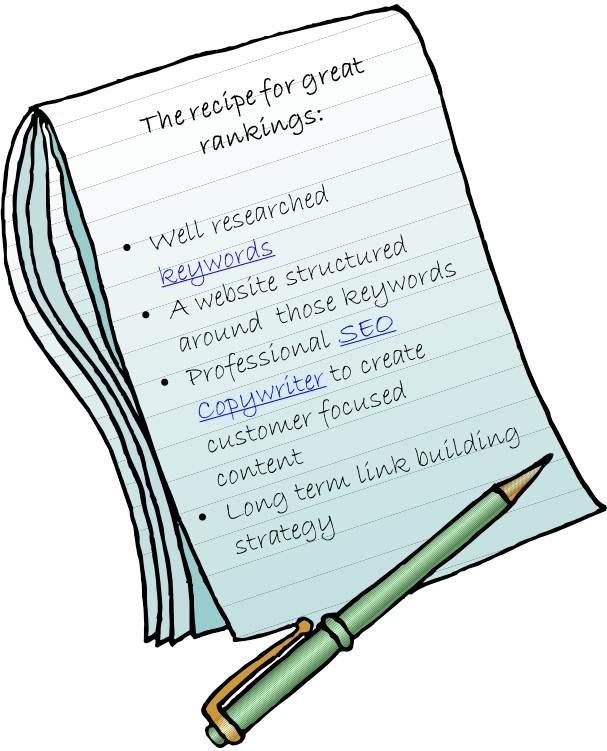Entries Tagged 'SEO copywriter' ↓
April 25th, 2012 — effective copy, keywords, search engine optimisation, seo, SEO copywriter, seo website copywriter
Keyword density is one of those phrases from the past that should be buried.
In the bad old days of SEO (search engine optimisation), it was thought to be the best on-screen method of boosting your search rankings.
The problem behind this thinking was that if you had 10 instances of your keyword or phrase on your web page, but a competitor had 15, they would rank higher than you.
Can you see where this is going?
That’s right – the end result was a list of search results that took you to unreadable, unimaginative and very uninteresting content.
SEO the right way
Thankfully, most SEO copywriters today understand the value of natural copy that is written for the reader and not the search engines.
You see, if you write in a natural style about a particular subject, the keywords will appear and at a level that you would expect. The result is great information that is easy to read and that will help your on-screen SEO strategy.
If you think this is all stuff and nonsense and that having a certain percentage of keywords is still the way to go, have a read of this from Google’s very own Matt Cutts (speaking at SXSW earlier this year):
“What about the people optimizing really hard and doing a lot of SEO. We don’t normally pre-announce changes but there is something we are working in the last few months and hope to release it in the next months or few weeks. We are trying to level the playing field a bit. All those people doing, for lack of a better word, over optimization or overly SEO – versus those making great content and great site. We are trying to make GoogleBot smarter, make our relevance better, and we are also looking for those who abuse it, like too many keywords on a page, or exchange way too many links or go well beyond what you normally expect. We have several engineers on my team working on this right now.”
Be natural
So there you go, if you continue to over stuff your content with keywords it will damage your website in the long run as well as having an immediate effect on your conversion rate.
Good SEO copy is:
- Natural
- Written for your reader
- Simple to understand
- Well laid out
It really is as easy as that.
November 23rd, 2011 — copywriting tips, keywords, search engine optimisation, seo, SEO copywriter

Are you fed up with unsolicited emails from SEO companies?
Barely a day goes by without at least one of their (often) brightly coloured emails popping into my inbox.
Every single one promises the earth in return for a small fortune.
But surely, if they are as good as they say they are they wouldn’t have to resort to cold emailing every business owner under the sun – would they?
A while back I wrote a post about simple SEO checks anyone can make. So, don’t respond to anyone who contacts you out of the blue, instead, grab a coffee and have a read of these posts. They should give you enough pointers to check the effectiveness of your site yourself (and tell you what to do to improve it).
Here goes – take a look at:
Simple SEO checks any small business can make
SEO copywriting – how it’s done
Page titles and SEO
The importance of off screen SEO
You can do basic SEO yourself – go on, give it a try.
November 7th, 2011 — search engine optimisation, seo, SEO copywriter, social media, social media marketing, social networking
Have you ever wondered how some people end up everywhere on the web?
If you Google their name, reams and reams of listings appear. How do they do it? How do they make themselves so visible?
The answer is good old fashioned search engine optimisation.
If you’re thinking I’ve finally lost it because surely, SEO is surely just for websites, let me put your mind at ease. No, I haven’t completely lost it. SEO is just as important for your social media profiles as it is for your website.
The whole point about filling in your profile on sites such as Twitter, LinkedIn and all the other social networking sites, is to make yourself visible to potential clients or business partners. So if you’re not making the most of them, why bother?
To illustrate my point, after Googling ‘Sally Ormond’ the first page of search results alone show 6 social media/networking profiles.
So not only does my website and blog appear, but anyone searching for information about me will also see my name splattered all over the web with numerous profiles (and blog posts and articles) detailing all the great work I do for my clients.
That’s pretty powerful stuff.
OK, I hear what you’re saying – Sally Ormond is my name as opposed to a search term that I would optimise for.
So what if I amended my search to ‘Sally Ormond Copywriter’ or ‘Sally Ormond freelance copywriter’?
Well….


As you can see, in both cases even more social media sites appear.
So there you go – this is why it’s essential to make your profiles stand out. That doesn’t mean you have to cram them with your keywords. But make sure your keyword (which is probably your primary business activity) appears near the beginning of your description.
Filling the web with great information about you and what you can do for your clients is essential if you want to position yourself as an expert in your field.
After all, it’s becoming more common for people to Google other people so they can find out a bit about them. If nothing shows up (or very little), what does that tell them?
October 24th, 2011 — copywriter, copywriting tips, marketing, SEO copywriter, seo website copywriter
 Have you noticed how different ideas spring up from time to time?
Have you noticed how different ideas spring up from time to time?
It’s the same in the marketing world. Every now and then someone comes up with, what appears to be, a brilliant idea. Every one jumps on the bandwagon, only to discover after a few months or a year that it doesn’t actually work at all.
It’s the same in copywriting. Take SEO copywriting as an example. At the outset, marketers would go to great pains to tell you that your copy had to contain a certain percentage of your keywords. The fact that this stipulation usually resulted in complete gibberish, didn’t seem to matter.
“It’s what the search engines want”
And like good little marketers we all followed suit and merrily stuffed our copy with keywords. Finally, people have seen sense and realised that good SEO copy is written for the reader – it should be:
- Interesting
- Relevant
- Of simple construction
- Contain loads of subheadings and bulleted lists
- …oh, and the odd keyword.
Basically, if you want your copy to work (regardless of its use), just follow the copywriting ‘rules’ that have stood the test of time.
Copywriting hints set in stone
1. Sell
You are writing copy for one reason, and one reason only – to sell.
Simply describing a product or service won’t convince anyone to buy it. So forget your flowery, adjective-laden text, make every word count and every word sell.
2. Formula
Don’t try to reinvent the wheel. Always use a tried and tested copywriting formula you know works:
- Understand your objective
- Clarify the main benefits
- Show how those benefits are delivered and how they will have a positive effect on your customer
- Back up your claims with evidence (testimonials, test results etc.)
- Sprinkle with sugar – make a time limited offer or give something free that will be of value to your customer
- Tell them to buy in your call to action
3. Command
If you write waffle that’s very wishy-washy, no one’s going to take you, or your product, seriously. Be forthright in your language.
Don’t ask them to…
“Call us, you know, if you have time, we don’t want to put you out.”
Tell them…
“Call now and make sure you don’t miss out on the offer of a lifetime.”
4. Clear benefits
It is the benefits of your product that will sell it. By benefits, I mean what it will do for your customer. It could save them money, streamline their business processes, or make them more attractive…
Try and stick to the primary benefit in your copy – the one that will really make a difference to them – make sure you tell them enough to make them say ‘yes’ and use it in your headline.
5. Offer
Whatever your offer is, make sure it’s a strong one that your customers will want.
6. Guarantee
Everyone loves peace of mind, so offering a guarantee will encourage your reader to trust you enough to buy from you.
7. Respond now!
Your strong call to action (mentioned in number 3) will tell your reader what you want them to do, but you have to give them a reason.
Making a limited offer will create a sense of urgency and force them to make a buying decision. It might be that the price is only held for 30 days, there is a limited number of your product available or they’ll receive a free gift if bought before a certain date.
8. Make it easy
If you want your reader to order from you, don’t make them jump through hoops.
You want to create as simple a process as possible, otherwise they won’t bother.
9. Free
Yes, using the word ‘free’ does work. People love to get something for nothing; it’s definitely a hot word worth using.
Over to you
These copywriting hints have served marketers well over the years, but the list is by no means exhaustive.
Can you add to it? If so, leave a comment below and let’s see how many tips we can come up with.
August 31st, 2011 — search engine optimisation, seo, SEO copywriter, seo website copywriter, website copywriter, website copywriting

From that list of ingredients, this post will look at the power of SEO copywriting.
When done well it will help your search engine rankings, attract readers and convert them into sales.
Done badly it could harm your rankings, repel customers and won’t convert a sausage.
So how can you make sure you get it right?
5 signs of good SEO copy
1. Write for your reader
There is a popular misconception that SEO copy has to be written for the search engines.
Wrong.
When writing your copy, always write it for your reader. Forget about keyword density – Google is more concerned with the amount of text, the topic you’re writing about (i.e. that your keywords in your title tags etc., are aligned with your content) and how hot the competition is for your particular keywords.
Always, always, always write to your reader first and foremost because they are the ones you want to read your copy and they are the ones you want to buy from you.
2. Don’t be repetitive
How many times have you read a website only to constantly hear the keywords being repeated?
Don’t stuff your copy with your keywords so it gets repetitive. After all if that was the only factor Google was interested in, all your competitor would have to do is insert one more keyword than you to rank higher.
And if that happened, the internet would be full of keyword-stuffed gibberish.
3. Don’t forget to link out
You already know the benefit of links into your website as part of your SEO strategy but don’t forget to link out too.
Linking out to authoritative articles not only adds to your reader experience and keeps Google happy; it could also help you attract inbound links.
4. Structure
Writing for the web is just like writing for anything else.
Your copy must be structured and attractive to the eye if you want people to read it.
Make sure it has a beginning, middle and an end with a strong headline. Split up your text into small paragraphs using sub headings as sign posts to help your reader skim the text.
Also, headings and subheadings are the ideal places for your primary and secondary keywords.
5. Be natural
There are loads of software programmes out there than can automate or spin articles for you. But they are no substitute for a well-considered, well-structured and well written article.
Don’t be tempted to use shortcuts.
So the moral of this post is to forget keyword density when it comes to your SEO copy. The most important thing to remember is to write for your reader. They are the ones you want to attract and they are the ones who you want to buy from you












